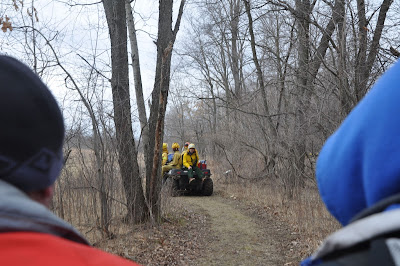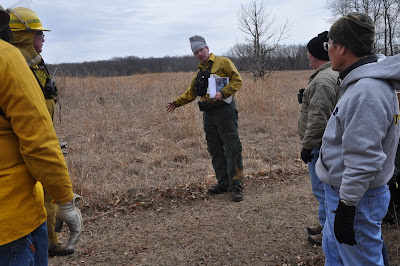Fire used to be a natural part of the prairie landscape. Before people dotted the plains, prairie fires were probably ignited by lightning strikes. The native peoples learned that fire renewed the prairies, and soon man-made fires were used to keep the trees at bay and to help renew the soils and fields.
As Europeans took over the continent, and their subsequent development, fire became the enemy of the people, so it was suppressed at every opportunity. It is only in the last few decades that we have learned a hard lesson: fire is important (vital) to maintaining many natural ecosystems.
So, as part of our land stewardship program at the Dahlem Conservancy, we hold prescription burns on our property to renew and maintain our patches of prairie. Gary told me this week that he was planning to schedule one sometime in the next few weeks. On Friday he said it might be sooner rather than later. Suddenly, yesterday we hear it might be today. And, at 8:30/9:00 this morning, the call came.
Of course, I couldn't wait to go and play. Years ago, when I worked in NJ, I got to participate in a prescribed burn. I was eager to be a part of one again - even if it was just on the sidelines taking photos.
Soon the official Burn Crew arrived and began unloading gear: driptorches (full of fuel - used to ignite the fire)...
...Indian tanks (these are the water packs used to put out stray flames and sparks)...
...and radios, radio harnesses, fire resistant clothing, hardhats, etc. Hooray! We were asked if any of us wanted to play...um...participate. I jumped at the opportunity and donned a yellow shirt, radio and harness, hardhat and indian tank.
And we drove off to the site.
Gary reviewed the map with Dave so everyone knew what was actually supposed to be burned.
Dave, the burn leader, explained that we were going to light a back burn on the downwind side of the site. The trail would act as a natural barrier, and the fire would burn into the field, upwind. The wind would work in our favor, helping to keep the fire under control.
His crew lit a small test patch just to make sure.
And we were off!
Most of the staff who participated were strictly there to keep the stray flames from getting out of control - we had our Indian tanks on our backs (40-60 pounds of water) and hand-pumped nozzles to squirt errant sparks.
Once a good buffer of 20-30 feet was burned, we didn't have to worry too much about sparks jumping the trail.
Sometimes, when the fire hit a good source of fuel (lots of dead vegetation), or when the wind gusted, we'd get some pretty robust burning.
Our crew went around the northern edge of the field, while the other crew headed around the southern edge.
Here we've turned the corner of the patch we were burning and Andy started to set the head fire - the one that would burn with the wind and into the back burn we'd just done.
There it goes!
In this pan you can see "our" fire creeping across the field toward "their" fire. Soon the two would meet in the middle...
...and whoosh!
The burned landscape:
Doing the burn on a chilly day put odds in our favor that snakes would be below ground - a concern here because we have massasauga rattlesnakes, which are protected. The only wildlife I saw was a vole making a hasty retreat into a woodchuck hole, and some birds flying overhead.
After the fire burned itself out in the first patch, the crew walked over to check out a second, smaller patch that Gary wanted torched as well. It was kind of like watching astronauts crossing the moon.
The second patch was significantly smaller, but also covered with last year's leaves. Dave wanted a line blown clear of leaves before we started, just to make doing the back burn a little easier and to cut down on the chances of some sparks setting the wrong side alight.
We refilled our tanks with water.
And soon we were off again! The fire burned pretty hot in here, but the area also resisted burning. The fellows with the drip cans had to continually lay down lines of flame. Later, Gary explained that the patches that resisted the fire were spotted knapweed, an invasive species. In order to affect these plants with fire, they have to be burned later in the season when their rosettes are above ground.
Someone is in for a rude awakening! (Man - I went to bed in a field, and today I wake up to find the whole landscape has changed!)
If the weather weren't so miserable out now, I'd be tempted to go back to the field tonight. It has been my experience that freshly-burned fields are great for owling. The mice and voles have nowhere to hide, so it's easy pickings for the raptors. Gary said that woodcocks also visit freshly-burned fields - must be the worms have nowhere to hide either! Maybe some night later in the week, when the rain stops.
So, Happy Spring, y'all!





















Wow, neat experience. Great photo story. Happy Spring to you too. Hooray for longer days, no more snow, all those good things.
ReplyDeleteoh my, I'm jealous, you got to "play" with fire (and firemen)- seems you are having a lot of interesting adventures out there !
ReplyDeletemeanwhile, we are getting more snow today (sigh)